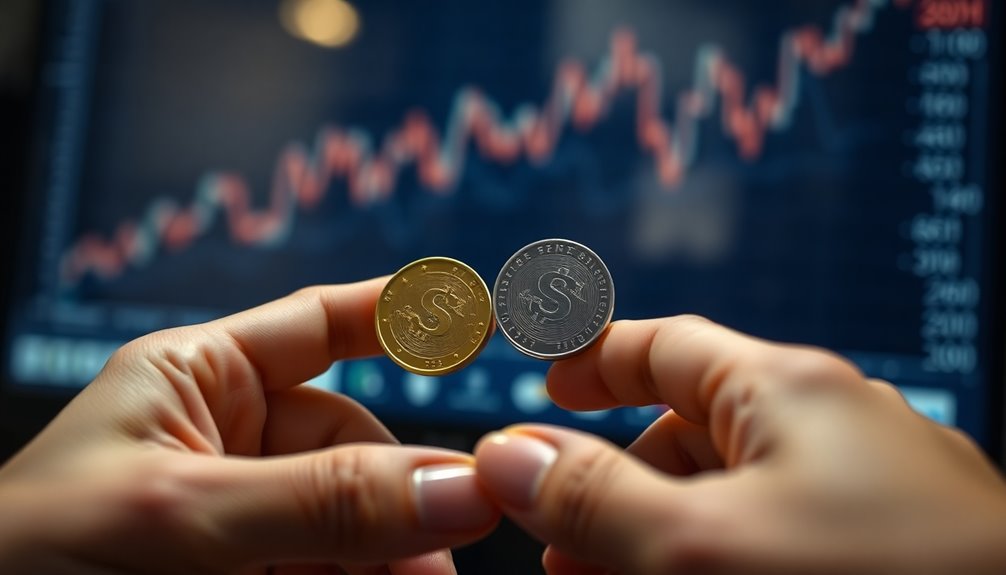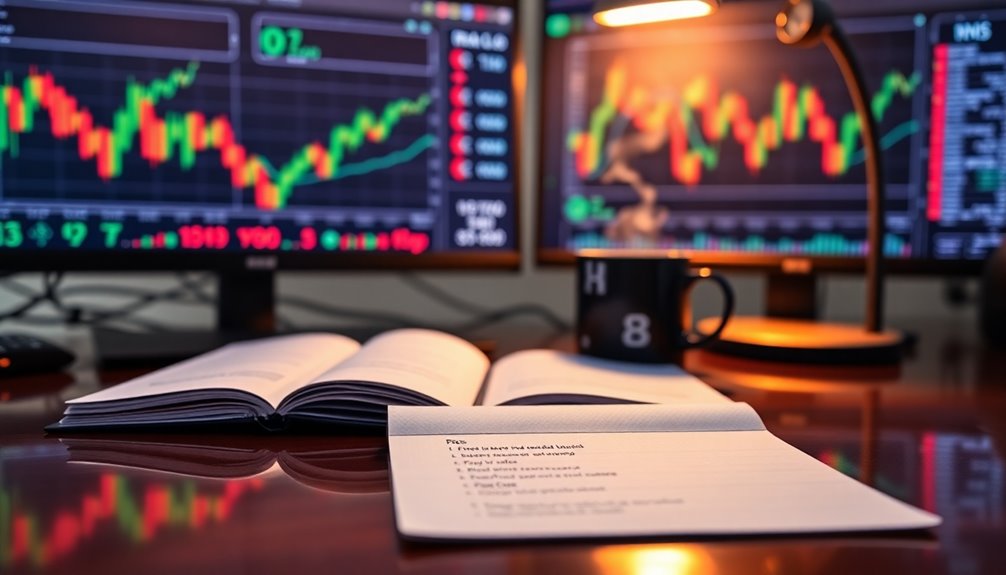Understanding carry trades involves exploiting interest rate differentials between currencies. You can profit by borrowing in a low-yielding currency and investing in a high-yielding one. For example, borrowing Japanese yen at 0.1% and investing in Australian dollars at 4% gives you a significant return from the 3.9% differential. However, you need to keep an eye on economic indicators and central bank decisions, as they can change interest rates and affect your profits. Risk management is crucial to navigate the potential downsides. Discovering the nuances of currency pairs and market conditions can enhance your trading strategy further.
Key Takeaways
- Carry trades capitalize on interest rate differentials between currencies, where profits arise from borrowing in low-yielding currencies and investing in high-yielding ones.
- Monitoring economic indicators like inflation and GDP is crucial, as they influence central bank interest rate decisions and currency values.
- Exchange rate fluctuations can quickly impact the profitability of carry trades, making risk management essential to protect gains.
- Diversification across multiple currency pairs and employing stop-loss orders can help mitigate risks associated with carry trades.
- Understanding market sentiment and global events is vital for making informed decisions and navigating the inherent volatility of carry trades.
Concept Overview and Fundamentals

While understanding carry trades might seem complex at first, grasping their fundamentals can enhance your trading strategy. The essence of carry trades lies in exploiting interest rate differentials between two currencies. Central banks play a vital role by adjusting interest rates, creating opportunities for traders like you. Stable interest rates are crucial for profitability, while predictable monetary policies allow you to anticipate future changes. Moreover, understanding interest rates is fundamental for executing the strategy effectively.
However, be aware of exchange rate risks, as fluctuations can quickly impact your gains. If the funding currency appreciates against the target currency, your profits could vanish. Therefore, staying informed about interest rate dynamics and market sentiment is essential in navigating carry trades effectively and safeguarding your investments.
Carry Trade Basics

Understanding the fundamentals of carry trades sets the stage for grasping their basic mechanics.
To enter a carry trade, you'll need to identify high-yielding and low-yielding currencies. Choose a currency pair that allows you to go long on the high-yielding currency while shorting the low-yielding one. Popular pairs like AUD/JPY and NZD/JPY often present good opportunities. Additionally, changes in interest rates can rapidly alter carry trade viability, which makes monitoring them essential.
Regularly check interest rates on platforms like FXSTREET and central bank websites to stay informed. You can earn daily interest calculated from the interest rate differential, so understanding this formula is crucial.
However, keep an eye on transaction costs, as they can affect your overall profitability. With a solid grasp of these basics, you're ready to explore carry trades further.
Interest Rate Differentials Explained

Interest rate differentials play a crucial role in the mechanics of carry trades, acting as the foundation for potential profit. This differential is the difference in interest rates between two currencies in a pair.
For instance, if you borrow Japanese yen at 0.1% and invest in U.S. dollars at 4%, you create a 3.9% interest rate differential, driving your profit. Central bank policies and economic indicators significantly influence these differentials, making them dynamic. You'll find that positive carry occurs when the differential is favorable, while negative carry leads to losses.
To maintain profitability, stable differentials are essential, as volatility can threaten your returns. Understanding these concepts helps you navigate carry trades more effectively, especially as central banks adapt their monetary policies in response to changing economic conditions.
Pros and Cons Analysis

Carry trades offer a unique blend of opportunities and risks that can impact your trading strategy.
On the positive side, they provide potential for high returns through yield advantages and diversification. You can enjoy predictable short-term gains and the flexibility to adapt your trading duration. Additionally, the strategy can be applied in both short-term and long-term contexts, allowing for versatility in trading goals.
However, be cautious of the downsides. Currency risk from exchange rate fluctuations can lead to losses, especially during market volatility. Interest rate changes by central banks can also affect profitability, while liquidity issues may hinder your ability to enter or exit trades swiftly.
Lastly, market risk from economic events can create rapid shifts in exchange rates, making it crucial to evaluate both the pros and cons thoroughly before engaging in carry trades.
Currency Pair Performance Analysis

When analyzing currency pair performance, it's essential to consider how various factors, such as exchange rate regimes and interest rate differentials, can influence your trading outcomes.
Floating exchange rates typically yield higher carry trade returns due to significant gross excess returns. In contrast, fixed regimes can lead to losses during collapses.
Wider interest rate spreads signal better potential returns, and when interest rate parity holds, your profitability increases.
The Japanese yen serves as a reliable funding currency because of its low rates and liquidity.
However, be mindful of how economic indicators and market sentiment can shape these dynamics.
Staying aware of these factors will help you make more informed trading decisions and enhance your carry trade strategy. By understanding the underlying economic indicators and geopolitical events that influence currency movements, traders can better anticipate market trends. Additionally, grasping the basis trading concept explained allows traders to leverage price discrepancies in different markets, further optimizing their strategies. Ultimately, continuous learning and adaptation are key components to achieving long-term success in carry trading.
Market Volatility Impacts Returns

Although market volatility can be unpredictable, it significantly influences the returns you can expect from your carry trades.
When volatility spikes, carry trades often suffer, as high-interest-rate currencies tend to deliver low returns during these turbulent times. You'll find that as the VIX rises, your positions might incur losses due to increasing margins and funding constraints. Historically, when volatility peaks, traders often unwind their positions, leading to steep losses. Additionally, your returns are sensitive to volatility regimes; a rise in implied volatility can lower your expected returns, while a decline typically favors high-carry currencies. This is particularly evident as global foreign-exchange volatility innovations effectively explain carry trade returns, highlighting the need for awareness of volatility dynamics.
Understanding these dynamics helps you navigate the risks associated with market volatility in your trading strategy.
Emerging Market Carry Trade Popularity

As investors seek higher returns, emerging markets have gained popularity for carry trades due to their attractive interest rate differentials. You'll notice that these markets often feature higher interest rates compared to developed countries, making them appealing for borrowing in low-interest currencies like the yen. This strategy hinges on the difference between borrowed and invested rates. However, be aware of the risks; emerging market currencies can suddenly devalue, influenced by central bank actions. Plus, volatility in these markets can lead to sharp exchange rate fluctuations, impacting your profitability. Understanding global market conditions and central bank policies is crucial, as they directly affect the success of your carry trade strategy. Recent trends indicate that currency carry trades have unwound due to changing interest rate expectations, which can further influence emerging market dynamics.
Leverage Economic Indicators Wisely

To successfully navigate carry trades, you need to leverage economic indicators effectively.
Start by understanding interest rate differentials; a wider spread often signals higher potential returns. Keep an eye on central bank decisions, as changes in interest rates can significantly impact your trade's profitability. This is particularly true since central banks can influence carry trade dynamics through their monetary policies.
Monitor economic conditions like inflation and GDP growth, since these factors influence interest rates and currency values. Pay attention to employment rates and consumer confidence, too, as they reflect broader economic trends.
Lastly, stay alert to exchange rate fluctuations driven by market sentiment, political events, or economic shocks. By analyzing these indicators, you'll be better equipped to make informed decisions and enhance your carry trade strategies.
Frequently Asked Questions
How Do Geopolitical Events Affect Carry Trades?
Geopolitical events significantly impact carry trades by altering interest rate differentials and market sentiment.
When tensions rise, central banks may change interest rates, affecting currency attractiveness. Rapid currency appreciation or devaluation can erase potential gains.
You'll also notice increased market volatility, prompting investors to react quickly, which can lead to crowded trades and sudden unwinding of positions.
Can Carry Trades Be Automated Using Trading Algorithms?
Automating carry trades with algorithms is like having a high-speed train on a smooth track—quick and efficient. You can execute trades faster than manual methods, minimizing errors and maximizing opportunities.
With real-time data analysis, your algorithms can adjust strategies dynamically, enhancing risk management. By integrating machine learning, you're not just reacting to market changes; you're anticipating them.
This automation allows you to trade consistently and discipline, freeing you from emotional decision-making.
What Are the Best Resources for Learning About Carry Trades?
To learn about carry trades, start with the Tastyfx Beginner's Guide to grasp forex basics and leverage concepts.
Then, check out CarryTrader.com for definitions, popular currency pairs, and conditions for success.
For in-depth analysis, explore the NBER Working Paper on carry trade returns and risk factors.
Lastly, watch Traders4Traders on YouTube for strategy breakdowns and insights on interest rate differentials.
These resources will help you build a solid foundation.
How Do Central Bank Policies Influence Carry Trade Strategies?
Imagine sailing a ship between two islands, where the winds are the central bank policies.
When they raise interest rates, the winds can shift, narrowing the gap you sail across. You'll find it less profitable to borrow from one island and invest in another.
Conversely, stable or low rates act like a steady breeze, guiding you smoothly to potential profits.
Your strategy must adapt to these changing winds to stay on course.
Are There Specific Currencies to Avoid for Carry Trades?
If you're considering currencies for carry trades, you'll want to steer clear of those with high volatility, like the Japanese Yen or Turkish Lira.
Currencies with negative interest rates, such as the Swiss Franc or Euro, can also be risky.
Additionally, avoid currencies from unstable economies like the Brazilian Real and South African Rand.
Lastly, unpredictable monetary policies make these currencies less appealing for your trading strategies, so choose wisely.
Conclusion
In the world of carry trades, you're venturing into a dance of opportunity and risk. While the allure of easy gains whispers sweetly in your ear, remember that the market can turn unexpectedly, like a fickle partner. By understanding the nuances of interest rate differentials and market dynamics, you can waltz gracefully through volatility. So, embrace the challenge and leverage your insights wisely, because in this game, it's not just about the chase; it's about mastering the rhythm.









